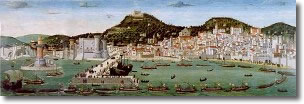Historical notes

- The "Strozzi" panel
Naples, a city of art, takes the form of an amphitheatre on the sea with Vesuvius, the coastal mountains and the islands of Capri, Ischia and Procida, and Capo Miseno as its landmarks.
Situated at the centre of the Mediterranean, the main town of the Campania Region and "capital" of Italy's Mezzogiorno, Naples extends over an area of 117.27 square km and has a population of about 1,020,120 inhabitants.
Its history is well-known. The territory was first colonized in 900 BC, almost 3000 years ago, when "Anatolian and Achaean merchants and travellers arrived in the gulf on their way to the ore trading centres of the High Tyrrhene" and founded Partenope in the area which includes the isle of Megaride (the present-day Castel dell'Ovo) and the Monte Echia Promontory (the present-day Monte di Dio and Pizzofalcone).
Later, after the wars, Partenope was abandoned and took the name of "Palepolis" (old city).
In 475 AD the inhabitants of Cuma founded Neapolis (new city) to the east of the original city.
Neapolis was built according to a plan called "Ippomadeo", or "per strigas", a network of streets placed at right angles which are still visible in the city of today.